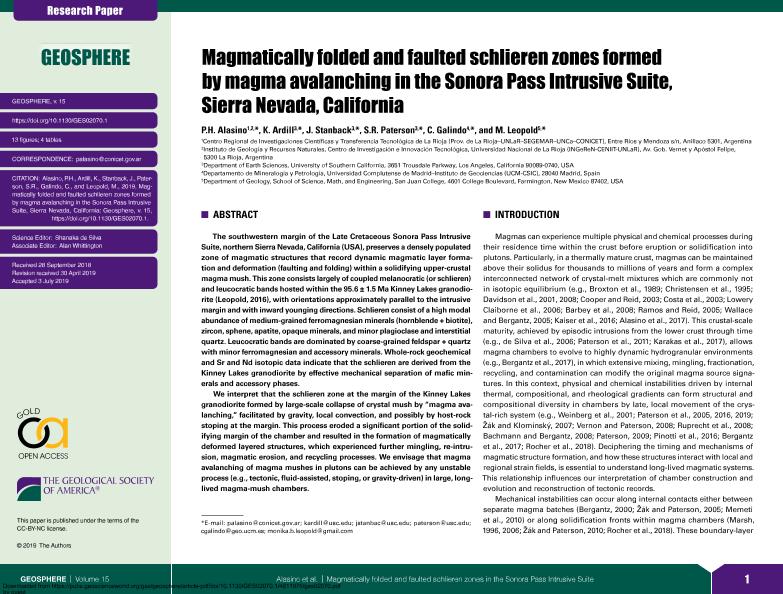Artículo
Magmatically folded and faulted schlieren zones formed by magma avalanching in the Sonora Pass Intrusive Suite, Sierra Nevada, California
Fecha de publicación:
08/2019
Editorial:
Geological Society of America
Revista:
Geosphere
ISSN:
1553-040X
Idioma:
Inglés
Tipo de recurso:
Artículo publicado
Clasificación temática:
Resumen
The southwestern margin of the Late Cretaceous Sonora Pass Intrusive Suite, northern Sierra Nevada, California (USA), preserves a densely populated zone of magmatic structures that record dynamic magmatic layer formation and deformation (faulting and folding) within a solidifying upper-crustal magma mush. This zone consists largely of coupled melanocratic (or schlieren) and leucocratic bands hosted within the 95.6 ± 1.5 Ma Kinney Lakes granodiorite (Leopold, 2016), with orientations approximately parallel to the intrusive margin and with inward younging directions. Schlieren consist of a high modal abundance of medium-grained ferromagnesian minerals (hornblende + biotite), zircon, sphene, apatite, opaque minerals, and minor plagioclase and interstitial quartz. Leucocratic bands are dominated by coarse-grained feldspar + quartz with minor ferromagnesian and accessory minerals. Whole-rock geochemical and Sr and Nd isotopic data indicate that the schlieren are derived from the Kinney Lakes granodiorite by effective mechanical separation of mafic minerals and accessory phases. We interpret that the schlieren zone at the margin of the Kinney Lakes granodiorite formed by large-scale collapse of crystal mush by “magma avalanching,” facilitated by gravity, local convection, and possibly by host-rock stoping at the margin. This process eroded a significant portion of the solidifying margin of the chamber and resulted in the formation of magmatically deformed layered structures, which experienced further mingling, re-intrusion, magmatic erosion, and recycling processes. We envisage that magma avalanching of magma mushes in plutons can be achieved by any unstable process (e.g., tectonic, fluid-assisted, stoping, or gravity-driven) in large, longlived magma-mush chambers.
Palabras clave:
MAGMATIC
,
SCHLIEREN
,
SONORA
,
NEVADA
Archivos asociados
Licencia
Identificadores
Colecciones
Articulos(CRILAR)
Articulos de CENTRO REGIONAL DE INV. CIENTIFICAS Y TRANSFERENCIA TECNOLOGICA DE ANILLACO
Articulos de CENTRO REGIONAL DE INV. CIENTIFICAS Y TRANSFERENCIA TECNOLOGICA DE ANILLACO
Citación
Alasino, Pablo Horacio; Ardill, K.; Stanback, J.; Paterson, Scott Robert; Galindo, C.; et al.; Magmatically folded and faulted schlieren zones formed by magma avalanching in the Sonora Pass Intrusive Suite, Sierra Nevada, California; Geological Society of America; Geosphere; 15; 5; 8-2019; 1677–1702
Compartir
Altmétricas




